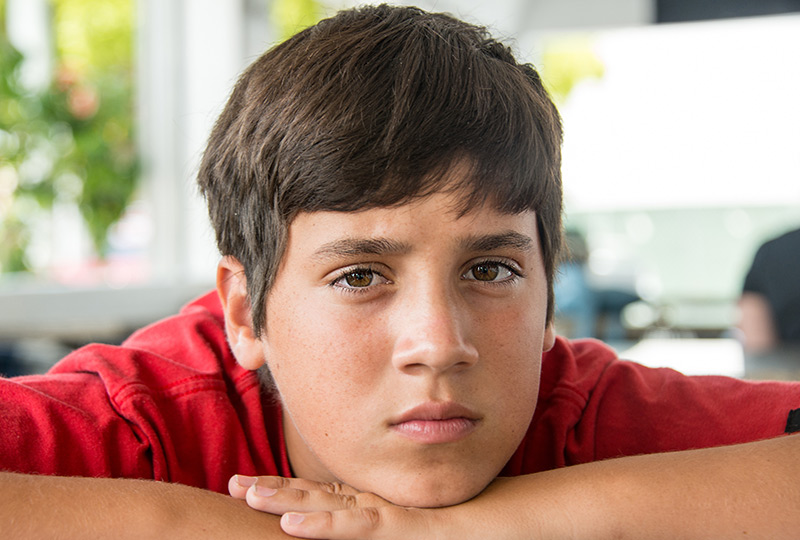There are different types of childhood anxiety, but they all limit a child’s ability to function.
Anxiety is a normal part of life. Everyone frets sometimes — over anything from a test to a blind date to speaking in public. But some children’s and teens’ anxiety goes beyond normal levels. Helping with childhood anxiety starts with learning more about this condition. Vanderbilt psychiatrist Margaret Benningfield, M.D., explains anxiety disorders in youth.
What is an anxiety disorder?
A child has an anxiety disorder if worrying prevents normal functioning in day-to-day life, Benningfield said. For example, many young children will feel intimidated in unfamiliar environments, such as a new preschool. They may cling to parents, avoid talking to others or wait to see how other children behave before taking any action themselves. Most children quickly warm up to their environments and begin interacting with other children and teachers.
Children with anxiety disorders, however, will have trouble adapting to unfamiliar environments. They may refuse to let go of their parents, or even refuse to go to school. When anxiety prevents children from acclimating and functioning in day-to-day activities, that’s a disorder.
Anxiety disorders are chronic. Most people with anxiety in childhood will need to manage it throughout life, Benningfield said. Mood disorders, such as depression, tend to be more episodic — they come and go, she said.
Anxiety in children can take several forms
Childhood anxiety falls into four categories:
- Generalized anxiety. Children with generalized anxiety disorder “can’t stop the worry,” Benningfield said. “They just can’t turn off the thoughts about ‘what if?’ ” These children may stress about events they see playing out in the news; or whether Mom loses her job. Children with anxiety disorders are especially sensitive and become preoccupied with such worries, Benningfield said.
- Social anxiety. Social anxiety is fear of dealing with people. Youth with social anxiety may be extremely distressed about giving presentations in class or getting through interactions that others find unremarkable. Teenagers suffering from social anxiety might refuse to go to school, Benningfield said, or avoid going to a restaurant because they can’t face the task of ordering food, “these kinds of things that are typical behaviors that we expect children to do.” But avoiding these activities can impair social development, among other consequences. Think of someone avoiding dating, job interviews or going away to college, Benningfield said.
- Specific phobias. Specific phobias are intense, irrational fears of things that are unlikely to cause actual harm. Common specific phobias include fears of insects, heights or needles. These fears typically don’t harm a child’s functioning to the same degree that generalized or social anxiety does, because the feared object or situation can often be avoided without too much impact on the child’s normal routine, Benningfield said. Specific phobias are the most common anxiety disorder in children. About 10 to 15 percent of children have these intense fears.
- Separation anxiety. Babies go through a normal developmental stage, usually around age 8 to 18 months, during which they get upset if they can’t see their parents. They eventually grow out of that fear. “When children do not develop the ability to separate from a caregiver by age 5 or 6, we become concerned about a separation anxiety disorder,” Benningfield said. In separation anxiety, children fear that something bad will happen to them or to the caregivers when they are apart; the thought of leaving a caregiver causes great distress. Obviously, this can create a big problem when parents are working and it’s time for the child to attend day care or be left with a relative. Therapy usually involves building the child’s ability to cope with being away from the parent, Benningfield said, so that the family can function.
How common are anxiety disorders in children?
Anxiety disorders are the most common type of mental health disorder in children and teens. About 1 in 5 children will have symptoms of anxiety that cause impairment. Anxiety is more prevalent than ADHD, and happens about twice as often in youth than the rate of depression, Benningfield said. About two-thirds of children with an anxiety disorder have more than one type, she said.
About 45 percent of teens with anxiety will have a depressive episode at some point. Half of those with anxiety drop out of high school or college. Their risk of addiction to alcohol or marijuana by age 24 is twice as high as non-anxious youth’s, Benningfield said. For these reasons, it’s important that children get treatment for anxiety.
How do professionals treat anxiety in children?
Unfortunately, children’s anxiety is often not treated at all.
“It’s really stunning to think that of all the engagement we have in mental health disorders, about 80 percent of children with anxiety disorders don’t get recognized and don’t get treatment,” Benningfield said.
One reason for that is the squeaky-wheel theory, she said. Because anxious, withdrawn children do not usually behave in a way that disrupts class at school, they are usually not referred for evaluation.
For those who get treatment, therapy usually involves talk therapy and/or medications, Benningfield said. Research suggests that a therapy called “exposure” is an important component for effective treatment. Exposure therapy teaches children to prepare for unfamiliar situations and practice typical social situations to overcome anxiety.
If you believe your child has an anxiety disorder, talk with your pediatrician, a teacher or school counselor. Parents should encourage children with anxiety to do things that are uncomfortable, Benningfield said. Facing their fears and mastering new skills is the most important work kids can do to battle anxiety.

Monroe Carell Jr. Children’s Hospital at Vanderbilt is among the top children’s hospitals in the nation. More than 500 physicians in 30 pediatric and surgical specialties offer everything from basic preventive care to treatment for the most complex pediatric conditions. Our specialists offer expert care close to home, throughout Middle Tennessee and beyond.

